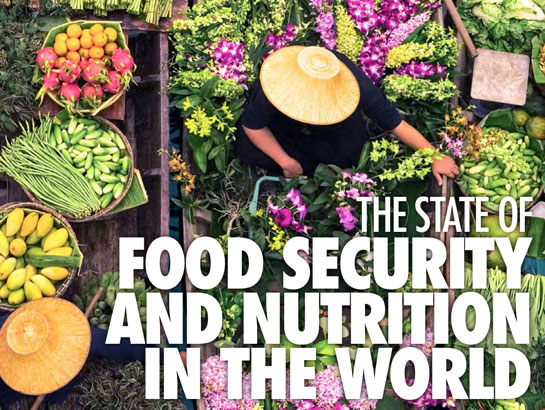An influential United Nations (UN) report on global food and nutrition security estimates that 3 billion people, or almost 40 percent of the world population, are currently unable to afford nutritious diets. The report, produced by several UN agencies active in food and hunger, also recommends biofortification of staple crops among the cost-effective, affordable responses that address widespread micronutrient deficiency—particularly among rural farming households.
The annual State of the Food Security and Nutrition in the World (SOFI) report is a go-to resource to track progress towards achieving relevant Sustainable Development Goals, particularly the SDG2 targets for food security and nutrition by the 2030 deadline. The authors of the 2020 edition argue that these targets are unattainable (particularly with the impacts of the COVID-19 pandemic) unless countries transform their food systems and increase access to nutritious and healthy diets.
Biofortification is the process of increasing the micronutrient density of staple crops and is targeted at smallholder farming families and other low-resource populations. The SOFI report’s authors note that biofortification can ensure that “the staple crop component of a diet is as nutritious as possible. This is particularly important for rural poor and small farming families in low- and middle-income countries whose diets continue to be dominated by staple foods and are not yet able to access a diversified healthy diet.”
Speaking at the virtual launch event for the SOFI 2020 report, Tijhani Muhammed-Bande, Permanent Representative of Nigeria to the UN and current President of the UN’s seventy-fourth session, said biofortification is part of the solution. “As we build back better, we must prioritize the farm-to-fork process of ensuring nutrient-rich food.” he said. “I call on all stakeholders to work with farmers to promote nutrient-dense crops and biofortification, paying particular heed to the needs of smallholder and subsistence farmers, women, and children,”
Indeed, for billions of people living on smallholder farms, diverse and nutritious diets are unaffordable and will likely remain so for many of them in coming decades. Biofortified crops, such as the more than 240 varieties released through facilitation by the HarvestPlus program, put essential micronutrients in the crops that these farming families grow and eat every day, at no extra cost to the farmer, and the nutrition stays in the planting material harvest after harvest.
Biofortification is a particularly relevant approach now, as the severe disruptions and economic tolls of the COVID-19 pandemic—and efforts to contain it—cut many families’ incomes and force them to rely more on relatively cheap but lower-nutrient staples such as rice, wheat, beans, and maize. According to analysis presented in the report, during 2020 the global COVID-19 pandemic will lead to between 83 million and 132 million additional undernourished people. Micronutrients are also needed for healthy immune systems – the first line of defense against viral infections, such as COVID-19.
The SOFI 2020 report is the latest endorsement by key UN agencies of the practicality and cost-effectiveness of biofortification. For example, the World Food Programme (WFP), in the latest update to its local and regional procurement policy, included biofortification as a complementary nutrient-sensitive intervention to promote healthy diets. The Food and Agriculture Organization of the United Nations (FAO) recently produced a joint brief with HarvestPlus highlighting biofortification as a food-systems solution that improves public health. And the State of the World’s Children Report by the United Nations International Children’s Fund (UNICEF) mentions biofortification as an effective way to reach vulnerable young children in rural areas.
The SOFI report puts forth striking numbers that underline the severity of the food and nutrition crisis. In 2019, 2 billion people did not have regular access to safe, nutritious, and sufficient food; 144 million children under five were stunted, and 690 million people went to bed hungry. If the trends continue, by 2030, more than 840 million people are expected to go to bed hungry—with Africa region being affected the most—and mortality and non-communicable diseases will cost more than USD 1.3 trillion in diet-related health costs annually. According to the report, adoption of healthy diets can reduce these health costs by 97 percent.
Also at the SOFI report launch event, Gilbert Houngbo, president of the International Fund for Agricultural Development (IFAD), noted that around 500 million small-scale farms are producing half of our global food supply, and it crucial to help increase their resilience. Indeed, by targeting smallholder farmers whose diets rely on staple foods and who have limited access to nutritious foods or other nutrition interventions, biofortification ensures that no one is left behind in the fight against hidden hunger worldwide. Biofortified crops are produced locally, rely on short supply chains, and are therefore more resilient to supply shocks. This would also minimize food waste, which is a prominent issue standing on the way to reach global food security.
The SOFI report lays out a menu of solutions to current challenges to global food and nutrition security. Biofortification has a well-deserved place as a climate-smart intervention that increases affordability and nutritious values and reaches vulnerable populations. HarvestPlus is doing its part to ensure nutritious diets are accessible for all.
